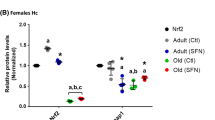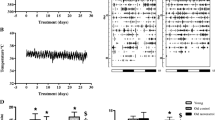Abstract
Previous studies have demonstrated that melatonin administration improves spatial learning and memory and hippocampal long-term potentiation in the adult Ts65Dn (TS) mouse, a model of Down syndrome (DS). This functional benefit of melatonin was accompanied by protection from cholinergic neurodegeneration and the attenuation of several hippocampal neuromorphological alterations in TS mice. Because oxidative stress contributes to the progression of cognitive deficits and neurodegeneration in DS, this study evaluates the antioxidant effects of melatonin in the brains of TS mice. Melatonin was administered to TS and control mice from 6 to 12 months of age and its effects on the oxidative state and levels of cellular senescence were evaluated. Melatonin treatment induced antioxidant and antiaging effects in the hippocampus of adult TS mice. Although melatonin administration did not regulate the activities of the main antioxidant enzymes (superoxide dismutase, catalase, glutathione peroxidase, glutathione reductase, and glutathione S-transferase) in the cortex or hippocampus, melatonin decreased protein and lipid oxidative damage by reducing the thiobarbituric acid reactive substances (TBARS) and protein carbonyls (PC) levels in the TS hippocampus due to its ability to act as a free radical scavenger. Consistent with this reduction in oxidative stress, melatonin also decreased hippocampal senescence in TS animals by normalizing the density of senescence-associated β-galactosidase positive cells in the hippocampus. These results showed that this treatment attenuated the oxidative damage and cellular senescence in the brain of TS mice and support the use of melatonin as a potential therapeutic agent for age-related cognitive deficits and neurodegeneration in adults with DS.




Similar content being viewed by others
References
Bartesaghi R, Guidi S, Ciani E (2011) Is it possible to improve neurodevelopmental abnormalities in Down syndrome? Rev Neurosci 22:419–455
Lott IT, Head E, Doran E et al (2006) Beta-amyloid, oxidative stress and Down syndrome. Curr Alzheimer Res 3:521–528
Sturgeon X, Gardiner KJ (2011) Transcript catalogs of human chromosome 21 and orthologous chimpanzee and mouse regions. Mamm Genome 22:261–271
Rueda N, Flórez J, Martínez-Cué C (2012) Mouse models of Down syndrome as a tool to unravel the causes of mental disabilities. Neural Plast 2012:584071
Hamlett ED, Boger HA, Ledreux A et al (2016) Cognitive impairment, neuroimaging, and alzheimer neuropathology in mouse models of Down syndrome. Curr Alzheimer Res 13:35–52
Perluigi M, du Domenico F, Fiorini A et al (2011) Oxidative stress occurs early in Down syndrome pregnancy: a redox proteomics analysis of amniotic fluid. Proteomics Clin Appl 5:167–168
Busciglio J, Yankner BA (1995) Apoptosis and increased generation of reactive oxygen species in down’s syndrome neurons in vitro. Nature 378:776–779
Pelsman A, Hoyo-Vadillo C, Gudasheva TA et al (2003) GVS-111 prevents oxidative damage and apoptosis in normal and down’s syndrome human cortical neurons. Int J Development Neurosci 21:117–124
Perluigi M, Butterfield DA (2012) Oxidative stress and Down syndrome: a route toward Alzheimer-like dementia. Curr Gerontol Geriatr Res 2012:724904
Corrales A, Vidal R, García S et al (2014) Chronic melatonin treatment rescues electrophysiological and neuromorphological deficits in a mouse model of Down syndrome. J Pineal Res 56:51–61
Lockrow J, Prakasam A, Huang P et al (2009) Cholinergic degeneration and memory loss delayed by vitamin E in a Down syndrome mouse model. Exp Neurol 216:278–289
Shichiri M, Yoshida Y, Ishida N et al (2011) α-Tocopherol suppresses lipid peroxidation and behavioral and cognitive impairments in the Ts65Dn mouse model of Down syndrome. Free Radic Biol Med 50:1801–1811
Busciglio J, Pelsman A, Helguera P et al (2007) NAP and ADNF-9 protect normal and down’s syndrome cortical neurons from oxidative damage and apoptosis. Curr Pharm Des 13:1091–1098
Zhou L, Chen X, Liu T et al (2015) Melatonin reverses H2 O2 -induced premature senescence in mesenchymal stem cells via the SIRT1-dependent pathway. J Pineal Res 59:190–205
Rodríguez-Sureda V, Vilches Á, Sánchez O et al (2015) Intracellular oxidant activity, antioxidant enzyme defense system, and cell senescence in fibroblasts with trisomy 21. Oxid Med Cell Longev 2015:509241
Vidal MA, Walker NJ, Napoli E et al (2012) Evaluation of senescence in mesenchymal stem cells isolated from equine bone marrow, adipose tissue, and umbilical cord tissue. Stem Cells Dev 21:273–283
Míguez JM, Recio J, Sánchez-Barceló E et al (1998) Changes with age in daytime and nighttime contents of melatonin, indoleamines, and catecholamines in the pineal gland: a comparative study in rat and syrian hamster. J Pineal Res 25:106–115
Ramirez-Rodriguez G, Ortiz-Lopez I, Dominguez-Alonso A et al (2011) Chronic treatment with melatonin stimulates dendrite maturation and complexity in adult hippocampal neurogenesis of mice. J Pineal Res 50:29–37
Liu XJ, Yuan L, Yang D et al (2013) Melatonin protects against amyloid-β-induced impairments of hippocampal LTP and spatial learning in rats. Synapse 67:626–636
Yoo DY, Kim W, Lee CH et al (2012) Melatonin improves d-galactose-induced aging effects on behavior, neurogenesis, and lipid peroxidation in the mouse dentate gyrus via increasing pCREB expression. J Pinal Res 52:21–28
Galano A, Tan DX, Reiter RJ (2011) Melatonin as a natural ally against oxidative stress: a physicochemical examination. J Pineal Res 51:1–16
Corrales A, Martínez P, García S et al (2013) Long-term oral administration of melatonin improves spatial learning and memory and protects against cholinergic degeneration in middle-aged Ts65Dn mice, a model of Down syndrome. J Pineal Res 54:346–358
Parisotto EB, Giaretta AG, Zamoner A et al (2015) Persistence of the benefit of an antioxidant therapy in children and teenagers with Down syndrome. Res Dev Disabil 45:14–20
Llorens-Martín M, Torres-Alemán I, Trejo JL (2006) Pronounced individual variation in the response to the stimulatory action of exercise on immature hippocampal neurons. Hippocampus 16:480–490
He N, Jin WL, Lok KH et al (2013) Amyloid-β(1–42) oligomer accelerates senescence in adult hippocampal neural stem/progenitor cells via formylpeptide receptor 2. Cell Death Dis 4:e924
Paz-Miguel JE, Flores R, Sánchez-Velasco P, et al (1999) Reactive oxygen intermediates during programmed cell death induced in the thymus of the Ts(1716)65Dn mouse, a murine model for human down’s syndrome. J Immunol 163:5399–5410
Garlet TR, Parisotto EB, de Medeiros G et al (2013) Systemic oxidative stress in children and teenagers with Down syndrome. Life Sci 93:558–563
Butterfield DA, Di Domenico F, Swomley AM, Head E, Perluigi M (2014) Redox proteomics analysis to decipher the neurobiology of Alzheimer-like neurodegeneration: overlaps in down’s syndrome and Alzheimer’s disease brain. Biochem J 463:177–189
de Haan JB, Wolvetang EJ, Cristiano F et al (1997) Reactive oxygen species and their contribution to pathology in Down syndrome. Adv Pharmacol 38:379–402
Sinet PM, Michelson AM, Bazin A et al (1975) Increase in glutathione peroxidase activity in erythrocytes from trisomy 21 subjects. Biochem Biophys Res Commun 67:910–915
Hamed RR, Maharem TM, Abdel-Meguid N et al (2011) Purification and biochemical characterization of glutathione S-transferase from Down syndrome and normal children erythrocytes: a comparative study. Res Dev Disabil 32:1470–1482
Hayes JD, McLellan LI (1999) Glutathione and glutathione-dependent enzymes represent a co-ordinately regulated defence against oxidative stress. Free Radic Res 31:273–300
Sebastià J, Cristòfol R, Pertusa M et al (2004) Down’s syndrome astrocytes have greater antioxidant capacity than euploid astrocytes. Eur J Neurosci 20:2355–2366
Rodriguez C, Mayo JC, Sainz RM et al (2004) Regulation of antioxidant enzymes: a significant role for melatonin. J Pineal Res 36:1–9
Manchester LC, Coto-Montes A, Boga JA, Andersen LP, Zhou Z, Galano A, Vriend J, Tan DX, Reiter RJ (2015) Melatonin: an ancient molecule that makes oxygen metabolically tolerable. J Pineal Res 59:403–419
Hardeland R (2005) Antioxidative protection by melatonin: multiplicity of mechanisms from radical detoxification to radical avoidance. Endocr 27:119–130
Olcese JM, Chao C, Mori T et al (2009) Protection against cognitive deficits and markers of neurodegeneration by long-term oral administration of melatonin in a transgenic model of Alzheimer disease. J Pineal Res 47:82–96
Feng Z, Qin C, Chang Y et al (2006) Early melatonin supplementation alleviates oxidative stress in a transgenic mouse model of Alzheimer’s disease. Free Radic Biol Med 40:101–109
Lott IT (2012) Antioxidants in Down syndrome. Biochim Biophys Acta 1822:657–663
Tan X, Guo X, Liu H (2013) Melatonin attenuates hippocampal neuron apoptosis and oxidative stress during chronic intermittent hypoxia via up-regulating B cell lymphoma-2 and down-regulating B cell lymphoma-2-associated X protein. Saudi Med J 34:701–708
Jang YJ, Hong HN, Lee JD, Hwang O (2000) Down-regulation of GTP cyclohydrolase I and tetrahydrobiopterin by melatonin. Neuroreport 11:3627–3630
Bekyarova G, Apostolova M, Kotzev I (2012) Melatonin protection against burn-induced hepatic injury by down-regulation of nuclear factor kappa B activation. Int J Immunopathol Pharmacol 25:591–596
Proietti S, Cucina A, D’Anselmi F, Dinicola S, Pasqualato A, Lisi E, Bizzarri M (2011) Melatonin and vitamin D3 synergistically down-regulate Akt and MDM2 leading to TGFβ-1-dependent growth inhibition of breast cancer cells. J Pineal Res 50:150–158
Caballero B, Vega-Naredo I, Sierra V, Huidobro-Fernández C, Soria-Valles C, De Gonzalo-Calvo D, Tolivia D, Gutierrez-Cuesta J, Pallas M, Camins A, Rodríguez-Colunga MJ, Coto-Montes A (2008) Favorable effects of a prolonged treatment with melatonin on the level of oxidative damage and neurodegeneration in senescence-accelerated mice. J Pineal Res 45:302–311
Tan DX, Manchester LC, Reiter RJ, Qi WB, Karbownik M, Calvo JR (2000) Significance of melatonin in antioxidative defense system: reactions and products. Biol Signals Recept 9:137–159
Baydas G, Ozveren F, Akdemir I, Tuzcu M, Yasar A (2005) Learning and memory deficits in rats induced by chronic thinner exposure are reversed by melatonin. J Pineal Res 39:50–56
Manda K, Anzai K, Kumari S, Bhatia AL (2007) Melatonin attenuates radiation-induced learning deficit and brain oxidative stress in mice. Acta Neurobiol Exp 67:63–70
Rueda N, Florez J, Martinez-Cue C (2008) Effects of chronic administration of SGS-111 during adulthood and during the pre- and post-natal periods on the cognitive deficits of Ts65Dn mice, a model of Down syndrome. Behav Brain Res 188:355–367
Ramirez-Rodriguez F, Klempin F, Babu H et al (2009) Melatonin modulates cell survival of new neurons in the hippocampus of adult mice. Neuropsychopharmacology 34:2180–2191
Manda K, Ueno M, Anzai K (2009) Cranial irradiation-induced inhibition of neurogenesis in hippocampal dentate gyrus of adult mice: attenuation by melatonin pretreatment. J Pineal Res 46:71–78
Crupi R, Mazzon E, Marino A et al (2011) Melatonin’s stimulatory effect on adult hippocampal neurogenesis in mice persists after ovariectomy. J Pineal Res 51:353–360
Acknowledgments
This work was supported by the Jerome Lejeune Foundation and the Spanish Ministry of Economy and Competitiveness (PSI2012-33652) and by a grant from CAPES/Brazil (proc. 2606/14-13).
Author Contributions
E. B. P. and S. G. performed the experiments. V. V. and S. L. developed the colony and karyotyped the animals. D. W. F. and E. S.-B. discussed the experiments. C. M.-C. and N. R. conceived the project; designed, supervised and interpreted the experiments; analyzed the data; and wrote the manuscript.
Author information
Authors and Affiliations
Corresponding author
Ethics declarations
Conflict of Interest
The authors report no conflicts of interest. The authors alone are responsible for the content and writing of the paper.
Rights and permissions
About this article
Cite this article
Parisotto, E.B., Vidal, V., García-Cerro, S. et al. Chronic Melatonin Administration Reduced Oxidative Damage and Cellular Senescence in the Hippocampus of a Mouse Model of Down Syndrome. Neurochem Res 41, 2904–2913 (2016). https://doi.org/10.1007/s11064-016-2008-8
Received:
Revised:
Accepted:
Published:
Issue Date:
DOI: https://doi.org/10.1007/s11064-016-2008-8




